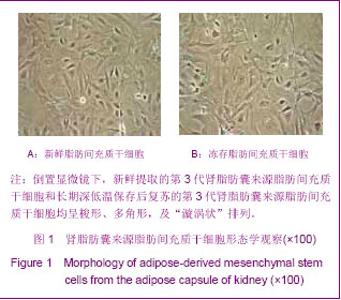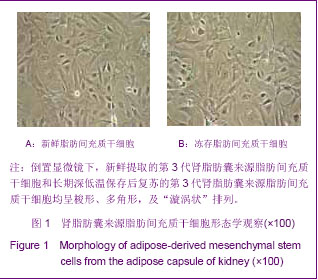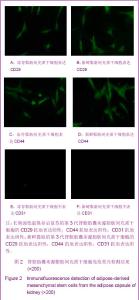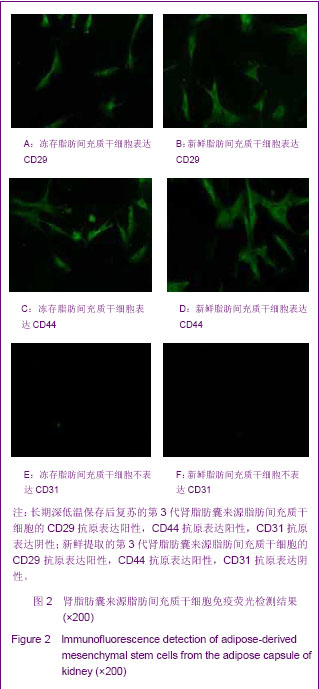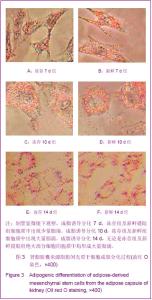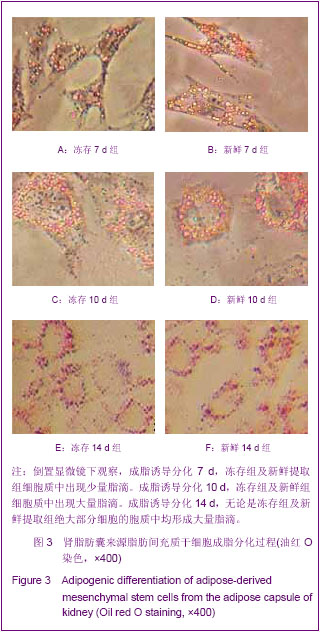Chinese Journal of Tissue Engineering Research
Previous Articles Next Articles
Estrogen effects on adipogenic differentiation of cryopreserved adipose-derived mesenchymal stem cells from the adipose capsule of kidney
Zhang Hui1, 2, Zheng Hong-guang2, Zhang De-wei2, Mei Yu-ming2
- 1Postgraduate Culture Base, General Hospital of Shenyang Military Region, Liaoning Medical University, Shenyang 110016, Liaoning Province, China; 2Department of Nephrology, General Hospital of Shenyang Military Region, Shenyang 110016, Liaoning Province, China
-
Received:2013-02-21Revised:2013-04-15Online:2013-07-02Published:2013-07-02 -
Contact:Zheng Hong-guang, M.D., Professor, Chief physician, Master’s supervisor, Department of Nephrology, General Hospital of Shenyang Military Region, Shenyang 110016, Liaoning Province, China phd528@sohu.com -
About author:Zhang Hui★, Studying for master’s degree, Postgraduate Culture Base, General Hospital of Shenyang Military Region, Liaoning Medical University, Shenyang 110016, Liaoning Province, China; Department of Nephrology, General Hospital of Shenyang Military Region, Shenyang 110016, Liaoning Province, China -
Supported by:the Scientific and Technological Plan of Liaoning Province in 2011 (First Batch), No. 2011225021*
CLC Number:
Cite this article
Zhang Hui, Zheng Hong-guang, Zhang De-wei, Mei Yu-ming. Estrogen effects on adipogenic differentiation of cryopreserved adipose-derived mesenchymal stem cells from the adipose capsule of kidney[J]. Chinese Journal of Tissue Engineering Research, doi: 10.3969/j.issn.2095-4344.2013.27.009.
share this article
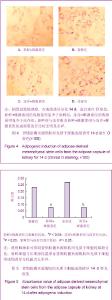
2.4 肾脂肪囊来源脂肪间充质干细胞成脂诱导分化情况 在成脂诱导分化14 d,进行油红O染色,结果见图4,新鲜+雌激素组的成脂量明显少于新鲜组,冻存+雌激素组的成脂量明显少于冻存组,说明雌激素抑制肾脂肪囊来源脂肪间充质干细胞成脂分化。新鲜组与冻存组及新鲜+雌激素组与冻存+雌激素组的成脂量进行比较无明显差异。 在成脂诱导剂及雌激素作用14 d,油红O染色后每组选取8孔异丙醇充分溶脂后分光光度计检测4组肾脂肪囊来源脂肪间充质干细胞细胞成脂诱导分化情况,见图5。新鲜细胞与长期深低温保存肾脂肪囊来源脂肪间充质干细胞的成脂诱导分化能力无差异。未添加雌激素组均获得较好的成脂诱导分化效果,添加雌激素组成脂诱导分化未获得良好分化效果,说明雌激素抑制肾脂肪囊来源脂肪间充质干细胞成脂分化。"
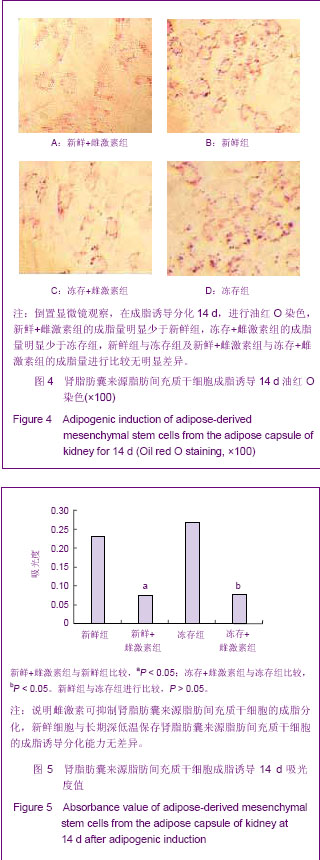
| [1] Zuk PA, Zhu M, Mizuno H, et al. Multilineage cells from human adipose tissue: implications for cell-based therapies. Tissue Eng. 2001;7(2):211-228.[2] Zuk PA, Zhu M, Ashjian P, et al. Human adipose tissue is a source of multipotent stem cells. Mol Biol Cell. 2002;13(12): 4279-4295.[3] Konno M, Hamabe A, Hasegawa S, et al. Adipose-derived mesenchymal stem cells and regenerative medicine. Dev Growth Differ. 2013;55(3):309-318.[4] Safford KM, Hicok KC, Safford SD, et al. Neurogenic differentiation of murine and human adipose-derived stromal cells. Biochem Biophys Res Commun. 2002;294(2):371-379.[5] D'Andrea F, De Francesco F, Ferraro GA, et al. Large-scale production of human adipose tissue from stem cells: a new tool for regenerative medicine and tissue banking. Tissue Eng Part C Methods. 2008;14(3):233-242.[6] Cao Y, Sun Z, Liao L, et al. Human adipose tissue-derived stem cells differentiate into endothelial cells in vitro and improve postnatal neovascularization in vivo. Biochem Biophys Res Commun. 2005;332(2):370-379.[7] Konno M, Hamazaki TS, Fukuda S, et al. Efficiently differentiating vascular endothelial cells from adipose tissue-derived mesenchymal stem cells in serum-free culture. Biochem Biophys Res Commun. 2010;400(4):461-465.[8] Pfeffer MA, Braunwald E. Experimental observations and clinical implications. Circulation.1990;81(4):1161-1172.[9] Rodriguez AM, Pisani D, Dechesne CA, et al. Transplantation of a multipotent cell population from human adipose tissue induces dystrophin expression in the immu-nocompetent mdx mouse. J Exp Med. 2005;201(9):1397-1405.[10] Herold K C, Gitelman SE, Masharani U, et al. A single course of anti-CD3 monoclonal antibody hOKT3gamma1(Ala-Ala) results in improvement in C-peptide responses and clinical parameters for at least 2 years after onset of type 1 diabetes. Diabetes. 2005;54(6):1763-1769.[11] Keymeulen B, Vandemeulebroucke E, Ziegler AG, et al. Insulin needs after CD3-antibody therapy in new-onset type 1 diabetes. N Engl J Med. 2005;352(25):2598-2608.[12] Santana A, Ensenat-Waser R, Arribas MI, et al. Insulin-producing cells derived from stem cells: recent progress and future directions. J Cell Mol Med. 2006;10(4): 866-883.[13] Gitelman SE, Haller MJ, Schatz D. Autologous nonmyeloablative hematopoietic stem cell transplantation in newly diagnosed type 1 diabetes mellitus. JAMA. 2009; 302(6): 624; author reply 624-625. [14] Goh BC, Thirumala S, Kilroy G, et al. Cryopreservation characteristics of adipose-derived stem cells: mintenance of Differentiation potential and viability. J Tissue Eng Regen Med. 2007;1(4):322-324.[15] Gruber CJ, Tschugguel W, Schneeberger C, et al. Production and actions of estrogens. N Engl J Med. 2002;346(5): 340-352.[16] Nickstick EA, Martello DD, Ray SK, et al .Estrogen treatment of spinal cord injury attenuates calpain activation and apoptosis. J Neurosci Res. 2006;84(5):1064-1075.[17] 田莉,蒋知新.雌激素对血管作用的研究进展[J].中国民康医志, 2005,17(11):685-687.[18] 周筠,张桦,蔡德鸿.雌激素对卵巢切除大鼠肾脏VDR mRNA 表达的影响[J].上海交通大学学报,2008,28(11):1474-1475.[19] ErhardtLR, HobbsFD. A global survey of physicians perceptions on cholesterol management: the from the heart study. Int J Clin Pract. 2007;61(7):1078-1085.[20] Yu CP, Ho JY, Huang YT, et al. Estrogen Inhibits renal cell carcinoma cell progression through estrogen receptor-β activation. PLoS One. 2013;8(2):e56667.[21] Rajalin AM, Pollock H, Aarnisalo P. ERR a regulates osteoblastic and adipogenic differentiation of mouse bone marrow mesenchymal stem cells. Biochem Biophys Res Commun. 2010;396(2):477-482.[22] Lee RH, Kim B, Choi I, et al. Characterization and expression analysis of mesenchymal stem cells from human bone marrow and adipose tissue. Cell Physiol Biochem. 2004; 14(4-6):311-324.[23] 吴畏,郑红光,张德伟,等.肾脂肪囊来源脂肪干细胞的体外培养及其生物学特性的研究[J]. 细胞与分子免疫学杂志,2010,26(11): 1078-1081.[24] Igor N, Oleg S. Long-term results of fat transplantation: clinical and histologic studies. Plast Reconstr Surg. 1994; 94(3):496-506.[25] Heino TJ, Hentunen TA. Differentiation of osteoblasts and osteocytes from mesenchymal stem cells. Curr Stem Cell Res Ther. 2008;3(2):131-145.[26] B ckesj CM, Li Y, Lindgren U, et al. Activation of Sirt1 decreases adipocyte formation during osteoblast differentiation of mesenchymal stem cells. Cells Tissues Organs. 2009;189(1-4):93-97.[27] Okazaki R, Inoue D, Shibata M, et al. Estrogen promotes early osteoblast differentiation and inhibits adipocyte differentiation in mouse bone marrow stromal cell lines that express estrogen receptor (ER) alpha or beta. Endocrinology. 2002;143(6):2349-2356.[28] Banfi A, Muraglia A, Dozin B, et al. Proliferation kinetices and differentiation potential of exvivo expanded human bone marrow stromal cell:Implication for their use in cell therapy. Exp Hematol. 2000;28(6):707-715.[29] Beresford JN, Bennett JH, Devlin C, et al. Evidence for an inverse relationship between the differentiation of adipocytic and osteogenic cells in rat marrow stromal cell cultures. J Cell Sci. 1992;102 ( Pt 2):341-351.[30] Ahdjoudj S, Lasmoles F, Oyajobi BO, et al. Reciprocal control of osteoblast/chondroblast and osteoblast/adipocyte differentiation of multipotential clonal human marrow stromal F/STRO-1(+) cells. J Cell Biochem. 2001;81(1):23-38. [31] Dieudonne MN, Leneveu MC, Giudicelli Y, et al. Evidence for functional estrogen receptors alpha and beta in human adipose cells: regional specificities and regulation by estrogens. Am J Physiol Cell Physiol. 2004;286(3):655-661.[32] Hong L, Colpan A, Peptan IA, et al. 17-Beta estradiol enhances osteogenic and adipogenic differentiation of human adipose-derived stromal cells. Tissue Eng. 2007; 13(6):1197-1203.[33] 訾利影,郑红光,张德伟,等.氯甲基苯甲酰胺标记大鼠肾脂肪囊来源脂肪间充质干细胞的可行性[J].中国组织工程研究,2012, 16(19): 3520-3524.[34] Ramírez-Zacarías JL, Castro-Muñozledo F, Kuri-Harcuch W. Quantitation of adipose conversion and triglycerides by staining intracytoplasmic lipids with Oil red. Histochemistry. 1992;97(6):493-497. |
| [1] | Pu Rui, Chen Ziyang, Yuan Lingyan. Characteristics and effects of exosomes from different cell sources in cardioprotection [J]. Chinese Journal of Tissue Engineering Research, 2021, 25(在线): 1-. |
| [2] | Zhang Xiumei, Zhai Yunkai, Zhao Jie, Zhao Meng. Research hotspots of organoid models in recent 10 years: a search in domestic and foreign databases [J]. Chinese Journal of Tissue Engineering Research, 2021, 25(8): 1249-1255. |
| [3] | Wang Zhengdong, Huang Na, Chen Jingxian, Zheng Zuobing, Hu Xinyu, Li Mei, Su Xiao, Su Xuesen, Yan Nan. Inhibitory effects of sodium butyrate on microglial activation and expression of inflammatory factors induced by fluorosis [J]. Chinese Journal of Tissue Engineering Research, 2021, 25(7): 1075-1080. |
| [4] | Wang Xianyao, Guan Yalin, Liu Zhongshan. Strategies for improving the therapeutic efficacy of mesenchymal stem cells in the treatment of nonhealing wounds [J]. Chinese Journal of Tissue Engineering Research, 2021, 25(7): 1081-1087. |
| [5] | Liao Chengcheng, An Jiaxing, Tan Zhangxue, Wang Qian, Liu Jianguo. Therapeutic target and application prospects of oral squamous cell carcinoma stem cells [J]. Chinese Journal of Tissue Engineering Research, 2021, 25(7): 1096-1103. |
| [6] | Xie Wenjia, Xia Tianjiao, Zhou Qingyun, Liu Yujia, Gu Xiaoping. Role of microglia-mediated neuronal injury in neurodegenerative diseases [J]. Chinese Journal of Tissue Engineering Research, 2021, 25(7): 1109-1115. |
| [7] | Li Shanshan, Guo Xiaoxiao, You Ran, Yang Xiufen, Zhao Lu, Chen Xi, Wang Yanling. Photoreceptor cell replacement therapy for retinal degeneration diseases [J]. Chinese Journal of Tissue Engineering Research, 2021, 25(7): 1116-1121. |
| [8] | Jiao Hui, Zhang Yining, Song Yuqing, Lin Yu, Wang Xiuli. Advances in research and application of breast cancer organoids [J]. Chinese Journal of Tissue Engineering Research, 2021, 25(7): 1122-1128. |
| [9] | Wang Shiqi, Zhang Jinsheng. Effects of Chinese medicine on proliferation, differentiation and aging of bone marrow mesenchymal stem cells regulating ischemia-hypoxia microenvironment [J]. Chinese Journal of Tissue Engineering Research, 2021, 25(7): 1129-1134. |
| [10] | Zeng Yanhua, Hao Yanlei. In vitro culture and purification of Schwann cells: a systematic review [J]. Chinese Journal of Tissue Engineering Research, 2021, 25(7): 1135-1141. |
| [11] | Kong Desheng, He Jingjing, Feng Baofeng, Guo Ruiyun, Asiamah Ernest Amponsah, Lü Fei, Zhang Shuhan, Zhang Xiaolin, Ma Jun, Cui Huixian. Efficacy of mesenchymal stem cells in the spinal cord injury of large animal models: a meta-analysis [J]. Chinese Journal of Tissue Engineering Research, 2021, 25(7): 1142-1148. |
| [12] | Hou Jingying, Yu Menglei, Guo Tianzhu, Long Huibao, Wu Hao. Hypoxia preconditioning promotes bone marrow mesenchymal stem cells survival and vascularization through the activation of HIF-1α/MALAT1/VEGFA pathway [J]. Chinese Journal of Tissue Engineering Research, 2021, 25(7): 985-990. |
| [13] | Shi Yangyang, Qin Yingfei, Wu Fuling, He Xiao, Zhang Xuejing. Pretreatment of placental mesenchymal stem cells to prevent bronchiolitis in mice [J]. Chinese Journal of Tissue Engineering Research, 2021, 25(7): 991-995. |
| [14] | Liang Xueqi, Guo Lijiao, Chen Hejie, Wu Jie, Sun Yaqi, Xing Zhikun, Zou Hailiang, Chen Xueling, Wu Xiangwei. Alveolar echinococcosis protoscolices inhibits the differentiation of bone marrow mesenchymal stem cells into fibroblasts [J]. Chinese Journal of Tissue Engineering Research, 2021, 25(7): 996-1001. |
| [15] | Fan Quanbao, Luo Huina, Wang Bingyun, Chen Shengfeng, Cui Lianxu, Jiang Wenkang, Zhao Mingming, Wang Jingjing, Luo Dongzhang, Chen Zhisheng, Bai Yinshan, Liu Canying, Zhang Hui. Biological characteristics of canine adipose-derived mesenchymal stem cells cultured in hypoxia [J]. Chinese Journal of Tissue Engineering Research, 2021, 25(7): 1002-1007. |
| Viewed | ||||||
|
Full text |
|
|||||
|
Abstract |
|
|||||
